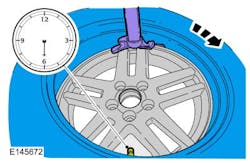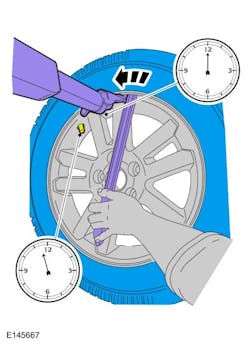OPERATION AND COMPONENT DESCRIPTION
When directed to train any TPMS sensors, use only the sensor training procedure outlined in this article. Do not use the TPMS reset procedure outlined in the owner's literature as this procedure does not program new sensors to the module.
The TPMS uses four valve stem mounted sensors to monitor tire pressure. These sensors wirelessly transmit tire pressure data to the RTM. The RTM is a radio signal receiver which collects the tire pressure data and sends the information to the BCM along a LIN. All TPMS functions are controlled by the BCM. The BCM compares the tire pressure data sent by the RTM with a programmed tire pressure. This programmed pressure is specified on the VC label and cannot be changed. If the actual tire pressure is less than the programmed tire pressure, the BCM sends a low tire pressure message to the IPC along the HS-CAN3. The IPC responds by illuminating the TPMS warning indicator and displaying a low tire pressure message in the message center. The TPMS sensors are trained (calibrated) to the BCM which records the unique identifier for each TPMS sensor and records the location of each sensor based on the training (calibration) order. It is necessary to train (calibrate) the TPMS sensors after a tire rotation on vehicles with different front and rear tire pressures. The BCM does not automatically recognize the sensor identifiers have been moved to different positions and retains the original position information for each sensor.
Components
BCM: The BCM is a multifunction module which monitors all sensor inputs and all CAN messages relating to the TPMS. The BCM records and retains the unique sensor identifier of each TPMS sensor. The BCM retains the previous sensor location information following a tire rotation. For the BCM to learn the new sensor location, the sensors must be trained(calibrated) to the BCM. Additionally, the sensors must be trained when a new BCM is installed.
When installing a new BCM, there are several procedures that must be carried out in order for the module to function correctly. These procedures include, but are not limited to: PMI, anti-theft parameter reset, programming keyless entry remote and setting customer preferences.
TPMS pressure data is cleared from the BCM when the module is flashed or reconfigured. When the data is cleared, the tire pressure DID's reset to the factory default of 1033 kPa (149.96 psi) and the IPC displays dashes for the tire pressures. The sensors must be activated to transmit the latest tire pressure information.
RTM: The RTM is a radio signal receiver which collects the tire pressure data from the TPMS sensors.
TPMS sensor: Each of the four TPMS sensors contains a battery, a tire pressure sensor and a radio transmitter. The TPMS sensor radio transmissions are sent approximately once every 60 seconds when the vehicle speed exceeds 32.2 km/h (20 mph).
TPMS PROGRAMMING
Programming With Scan Tool
The TPMS can be placed into learn mode using a diagnostic scan tool or manually where a diagnostic scan tool is not available. The horn will sound once and the TPMS indicator will flash if the training mode has been entered successfully. If equipped, the message center will display TRAIN Left Front (LF) TIRE.
Enter Training Mode With IDS Scan Tool
1) Select Chassis.
2) Select TPMS.
3) Select Training Mode.Use the General Equipment: Ford Diagnostic Equipment
Enter Training Mode With FDRS Scan Tool
1) Select Toolbox.
2) Select BCM
3) Select BCM — TPMS Initialization. Use the General Equipment: Ford Diagnostic Equipment.
Programming Without Scan Tool
The horn will sound once and the TPMS indicator will flash if the training mode has been entered successfully. If equipped, the message center will display TRAIN Left Front (LF) TIRE.
1) With the ignition OFF, press and release the brake pedal.
2) Using the start/stop switch, position the ignition from OFF to RUN three times, ending in the RUN position.
3) Press and release the brake pedal.
4) Position the ignition to OFF position.
5) Using the start/stop switch, position the ignition from OFF to RUN three times, ending in the RUN position
4) Place the wheel and tire assembly on the turntable of the tire machine with the valve stem at the 11:30 position and the machine arm at the 12 o'clock position and demount the outer bead from the wheel.
Index-mark the valve stem and wheel weight positions on the tire.
5) Reset the wheel and tire assembly on the turntable of the tire machine with the valve stem at the 11:30 position and the machine arm at the 12 o'clock position and dismount the inner bead from the wheel.
6) Remove and discard the TPMS sensor-to-valve stem screw. Separate the TPMS sensor from the valve stem. A new valve stem must be installed whenever a new tire or wheel is installed.
7) Using a suitable valve stem remover/installer, remove and discard the valve stem. Use the General Equipment: Wooden Block. Use care not to damage the wheel surface when removing the valve stem.
When installing a new wheel, always install a new valve stem and sensor screw. Reuse the TPMS sensor from the previous wheel if possible. The TPMS will not have to be trained if the sensor is reused. If the TPMS sensor is being reused, inspect the TPMS sensor for damage and install a new sensor as necessary.
8) Position the new valve stem onto the TPMS sensor and install the new screw.
To prevent TPMS sensor and valve stem damage, the valve stem must be installed onto the TPMS sensor and then installed into the wheel as an assembly.
ASSEMBLY
Damage to the TPMS sensor may result if the tire mounting is not carried out as instructed.
1) Using a suitable valve stem installer, install the new valve stem and TPMS sensor assembly. Use the General Equipment: Wooden Block.
It is important to pull the valve stem and TPMS sensor assembly through the wheel rim hole in a direction parallel to the valve stem hole axis. If the assembly is pulled through at an angle, damage to the valve stem and sensor assembly may occur. Use care not to damage the wheel surface when installing the valve stem and TPMS sensor assembly. Lubricate the valve stem with soapy water and install the valve stem and TPMS sensor assembly into the wheel using a block of wood and a suitable valve stem installer.
2) Position the wheel on the turntable of the tire machine, then lubricate and position the bottom bead of the tire on the wheel.
Lubricate the tire beads using a suitable fast-drying, corrosion-inhibiting tire bead lubricant. Do not mount the tire at this time.
3) Position the wheel to align the valve stem with the machine arm, at the 6 o'clock position, and mount the bottom bead of the tire.
4) Reposition the wheel to align the valve stem with the machine arm at the 6 o'clock position and mount the top bead of the tire.
5) Inflate the tire to the pressure specified on the VC label located on the driver door or door pillar.
Use only the Digital Tire Pressure Gauge any time tire pressures are measured to be sure that accurate values are obtained.
6) Proceed to the next step if the tire beads do not seat at the specified inflation pressure.
• Relubricate the tire bead and wheel bead seat area.
• Install a remote valve and pressure gauge.
• Wear eye and ear protection and stand at a minimum of 12 feet away from the wheel and tire assembly.
• Inflate the tire using the remote valve and tire gauge until the beads have seated or until the pressure gauge is 138 kPa (20 psi) more than maximum inflation pressure on tire sidewall. If beads have not seated, deflate the tire and proceed to the next step.
• Place the wheel and tire assembly in an OSHA-approved tire safety cage.
• Inflate the tire using the remote valve and pressure gauge until the beads have seated or until the pressure gauge is 276 kPa (40 psi) more than maximum inflation pressure on the tire sidewall. Do not exceed 276 kPa (40 psi) above the maximum pressure on tire sidewall. Install a new tire if the beads do not seat at this pressure.
WARNING: If there is a need to exceed the maximum pressure indicated on the sidewall of the tire in order to seat the beads, follow all steps listed above. Failure to follow these steps may result in serious personal injury. These steps should only be carried out if the tire beads cannot be seated by inflating the tire up to the maximum inflation pressure listed on the tire sidewall.
7) Install the wheel and tire.
TORQUE SPECIFICATIONS
Component Torque
Wheel Nut 150 lb.ft (204 Nm)
TPMS Sensor 13 lb.in (1.5 Nm)




